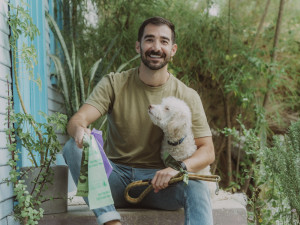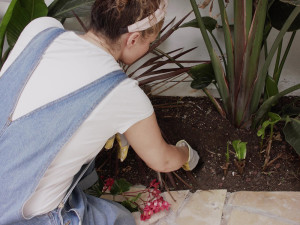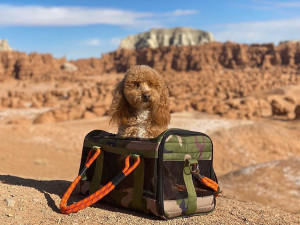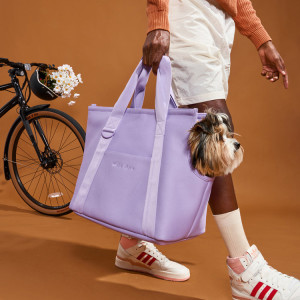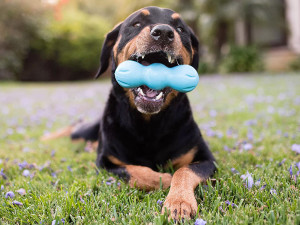Does Your City Have a Dog Poop Problem? This Could Help
It’s a (literally) dirty business. Here’s how two cities found an eco-friendly way to control it.
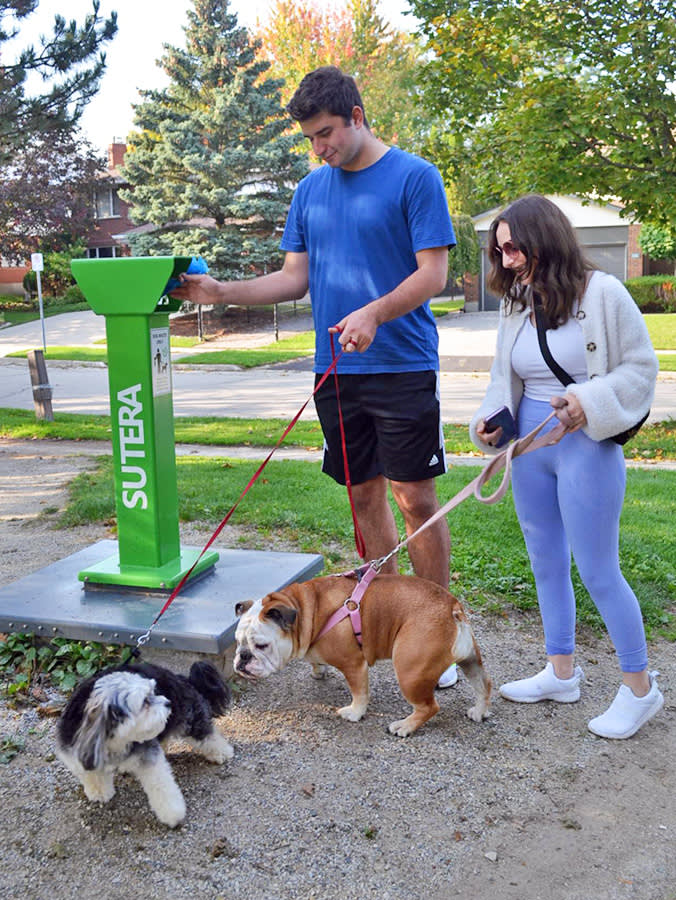
share article
For the next few minutes, we’re going to ask you to think deeply about the “P” word. Nope, not pizza, poolside vacations, or the wildly underrated Taylor Swift anthem “Picture to Burn.” We’re talking poop.
It turns out that compared to the systems we’ve engineered to handle human waste, dog poop disposal is rather primitive. Oftentimes, the stuff that doesn’t end up on your shoe heads straight for the landfill, where it contributes to the ballooning greenhouse gas crisis. But thanks to one smart design solution, a few eager communities in Canada, and a group of cooperative pet parents, we could be stepping into a new era for pup poop.
A new plan for poop.
Overflowing bins were the norm in Mississauga, a city in southeastern Ontario, Canada with about 800,000 people and 23.6 million poundsopens in a new tab of annual dog poop. A few years ago, city officials grew tired of seeing so much of it on the ground, stuffed into trash cans, or contaminating recycling bins, so they called up the waste management company Suteraopens in a new tab.
“We never thought we were going to get into the dog waste business,” Mike Kasij, the director of business development at Sutera, says on a call with us. The company got its start making industrial garbage cans primarily for construction sites but kept fielding inquiries for containers specifically designed for dog waste.
In 2018, Sutera used its waste management expertise to build a better solution for pet parents. The result is an in-ground waste unitopens in a new tab designed to covertly hold up to 500 to 600 pounds of dog waste. The leech-proof system sits underground, so its contents don’t heat up and release odors as quickly. Instead of needing to be emptied by hand daily, these units can be cleared via crane truck every month or so, saving trash collectors some heavy lifting and poop-grazing. Once collected, they are sent off for processing at a waste management facility, successfully averting landfills.
The genius of the units (which are clearly marked to be for dog waste only, plus any kind of bag it’s in) is that they hold a lot of a single type of waste stream. This makes it easier for composting facilities, waste-to-energy facilities, and anaerobic digesters, which use microorganisms to break down biodegradable materials, to process them.
“Our product is designed for urban use and park use, with the intent of keeping the surrounding area clean,” Kasij says. They’ve made a real difference in communities like Mississauga, which kicked off a pilot program of 14 in-ground containers in 2019.
“By demonstrating the reduction of recycling contamination, reduced need for pick-up, limited handling from city staff, and positive feedback from park visitors, the program was approved as a permanent program in 2021,” Nadia Paladino the city’s director of parks, forestry, and environment tells us. “As of today, there are a total of 24 containers in use resulting in total collection and diversion of an estimated 100 metric tonnes (110 tons) to date. Additional park locations and number of units are being reviewed for future installations.”
Dog waste is so crappy for the environment—here’s why.
There’s a reason more cities need solutions similar to the one Mississauga has found. Dog waste is an environmental issue, even when it’s collected in a “compostable” bag. While it is technically possible to compost dog poopopens in a new tab, it needs to be done under special conditions, separate from other types of organic waste.
This means that most baggies of dog poop currently go to landfills where they sit releasing carbon dioxide and methane for eons. In the United States, dogs leave behind about 11 million tons of waste annuallyopens in a new tab — that’s more than 30 Empire State Buildings’ worth of doo destined for the dump.
Leaving poop on the ground opens in a new tab to decompose naturally isn’t a better solution. Not only is it a surefire way to tick off your neighbors, but it’s a bona-fide public safety hazard. One tiny gram of dog waste contains an estimated 23 million bacteriaopens in a new tab — some of which can be potentially harmful. As feces decomposes, it throws off the nutrient composition of the surrounding soil.
Eventually, it washes into the water system where its high nitrogen and phosphorus content can harm freshwater ecosystems. One study by the Maryland Department of the Environmentopens in a new tab found that 26 percent of the bacteria from water samples in Baltimore’s Patapsco River could be traced back to pet waste.
This leaves us with a crappy problem: public trash cans overflowing with landfill-destined waste. They look bad, smell even worse, and are a pain for the people walking by them — not to mention, the sanitation workers who need to empty them.
To fix the problem, we just need to, uh, spread the solution.
Mississauga isn’t the only community putting the green units to good use. Over in nearby Waterlooopens in a new tab, the city’s “poop power” system features 22 bins that get sent to a waste-to-energy facility to be incinerated for power. These facilities aren’t a perfect solution (they come with pollution concerns and hefty emissionsopens in a new tab of their own), but they do keep trash out of the landfill and turn it into something useful. As of 2022, Waterloo had diverted 90,000 pounds of dog wasteopens in a new tab from local landfills and created enough energy to power 25 homes for a year.
Sutera is hoping for more success stories like these as it continues to install bins across Canada and down into the U.S. (the first just broke ground in Portland, Oregon). At the time of this writingopens in a new tab, they’d saved 409,396 kilograms (902,553 pounds) of poop from landfills — the weight of 68 fully-grown African bush elephants. “As we expand, these numbers will just become exponentially greater,” Kasij says.
The company has also rolled out a phone appopens in a new tab to show pet parents in participating communities where their nearest drop-off is, and kicked off collaborations with local pet stores and other organizations to incentivize use through rewards and prizes. It’s all in an effort to get people to think about the “P” word a little more often.
“Garbage in general is usually an afterthought… A lot of what we do raise the awareness of dog waste as a solid waste stream that needs attention,” Kasij adds.
As someone who lives in what feels like the dog-poop capital of the world — New York Cityopens in a new tab — I’m eager to get these bins on my block. And you can request them, too, by signing this petition to have them installed in your areaopens in a new tab. In the meantime, you can look into any other dog waste recycling options that exist around you.
While the most sustainable solution is always to generate less waste in the first place, it’s not exactly easy to tell your dog to hold it in. We need better solutions to handle a waste stream that isn’t going anywhere soon — and this is a big paw print in the right direction.
References:

Emma Loewe
Emma is a writer, editor, and environmentalist based in New York City. She is the senior sustainability editor at mindbodygreen, the author of Return To Nature: The New Science of How Natural Landscapes Restore Us (April 2022), and the co-author of The Spirit Almanac: A Modern Guide To Ancient Self-Care. While she doesn’t have any pets of her own, she is a loving dog aunt to Pip the pup.
Related articles
![Man shopping in a pet store reading product information]() opens in a new tab
opens in a new tabYour Comprehensive Guide to Eco-Labels on Pet Products
Here are the sustainability buzzwords you should look out for on the packages of your fave products.
![woman holding beautiful cat]() opens in a new tab
opens in a new tab3 Sustainability Reasons to Adopt Your Next Pet From a Shelter
Cue Sarah McLachlan.
![A dog in the desert modeling in a dog carrier bag.]() opens in a new tab
opens in a new tab10 Pet Brands Pledging to Save the Planet
A few of our favorite brands participating in Patagonia’s 1% for the Planet global movement — makers of kibble to catnip to carriers.
![petaluma sustainable pet food the wildest mars]() opens in a new tab
opens in a new tabThe Sustainable Pet Food Movement is Fired Up
From cricket kibble to miso mice, leading brands are exploring how sustainable pet food products can reduce carbon paw prints.
![A man carrying a dog in a purple dog carrier tote.]() opens in a new tab
opens in a new tabThe Coolest Pet Gear Made From Recycled Materials
7 brands transforming ocean-bound water bottles into well-designed dog accessories.
![Doberman dog chewing West Paw blue chew toy happily]() opens in a new tab
opens in a new tabWest Paw Is Leading the Pack in Pet Sustainability
Founder Spencer Williams shares his top tips for pet parents looking to lighten their impact.
